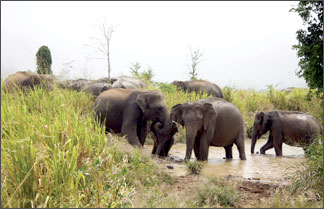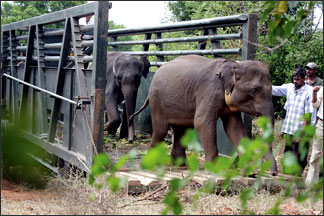Graduation day
Life begins anew at the Udawalawe National Park:
By Dhaneshi Yatawara
[email protected]
Its been a week since Minoli, Senani, Asha, Marga, Atlas, Nalaka,
Tharos and Baby blue were sent away from their nursery. Now this
four-year-old elephant team, the 08th Batch of the Elephant Transit Home
or better known as ‘Eth Athuru Sevana’ - has to survive totally on their
own against the challenges of Mother Nature.
 Few days back, the monitoring team had seen them roaming with a herd
of female elephants in Thimbirimankada in the Gonawid dagala area which
is four and half kilometres from the place where they were released to
the wild in Seenuggala. All eight of them have been roaming together by
the side of the resevoir in that area. Few days back, the monitoring team had seen them roaming with a herd
of female elephants in Thimbirimankada in the Gonawid dagala area which
is four and half kilometres from the place where they were released to
the wild in Seenuggala. All eight of them have been roaming together by
the side of the resevoir in that area.
“They are used to the Udawalawa forest,” said Dr. Suhada Jayawardane,
the veterinarian of the Elephant Transit Home (ETH). “Even when they
were under our care we release them to these forests in the day time.
They stay as one herd and they roam in the forest as they like. This is
important simply because it is going to be their future home,” Dr.
Jayawardane added.
According to him the ones who are also fed with milk rush back to the
ETH for their feeding hours and others, well...at times need to be
dragged in by the mahouts.
The day starts around six in the morning followed by eight milk
‘meals’. Those less than one year old are given approximately 4.7litres
(six bottles of 750ml). This is the maximum. According to the
care-takers this also depends on the weight of the young elephant. They
would start feeding on rough food, that is grass, when they are around
six months. Gradually they will totally convert to grass and herbs when
they are two and half years old.
These little ones know how to find food, how to extract food, where
to find water and almost all the basic necessities to survive in the
Udawalawa forest - home to the ‘Walawe Raja’ the forty-year-old hefty
looking elephant, the pride of Udawalwa. Now they have to gain more
experience to live in the jungle as they grow up.
They have just touched the waves of the sea of knowledge infront of
them. They will learn a lot in their long years of life - may be from
Uncle Walawe Raja and all the other elephant uncles and aunts they would
meet.
“Elephant herds do welcome new comers. If someone says that normally
they do not accept new comers like these young elephants whom we release
to the wild, it is totally a myth,” Dr. Tharaka Prasad, a Deputy
Director of the Wild Life Conservation Department told us. Confirming
his statement Dr. Jayawardana explained that acceptance or nonacceptance
depends on the nature of the herd. Like humans, elephants also have
different characteristics.
|

First steps towards an independent life
Pix: Thilak Perera |
It all started on June 14. The eighth batch of the ETH was going to
leave their nursery. May be the day started for them just like the other
days and I wondered whether they sensed the change that was yet to take
place, since they are the smartest animals walking on this earth. The
08th batch was going to face the toughest challenge, just like the other
ones of their previous batches.
Saving the Sri Lankan elephant is the biggest challenge infront of
these eight elephant youngsters. And will be the responsibility of the
elephant youngsters who are yet to come. On top of all, it is the utmost
duty of us, the humans, to protect these innocent creatures and let them
live peacefully in their wilderness.
Elephant population was mounting up to 12, 000 at the turn of the
century in Sri Lanka, Dr. Jayawardane said. Dr. Jayawardana explained
this at the special briefing he made to the distinguished gathering at
the newly built elephant museum, in the middle of Udawalawa National
Park.
The elephant population started declining hastily, with the rapid
pace of mega development projects implemented in the dry zone, the main
habitat of elephants. Thick jungles are not favourites of the elephants.
Now we have only 4000 elephants.
“These are globally endangered species. The world only has these 4000
as the Sri Lankan elephant,” Dr. Jayawardana reiterated. Elephants are
threatened by the human population increase from four million to the
present nearly 20 million.
According to statistics 150 elephants die each year and 50 humans die
as a result of Human elephant conflict, in Sri Lanka. The main threat is
killing elephants to protect food and crops. Others are poaching,
deforestation, drought and starvation. Today the Sri Lankan Elephant
mainly occupies the dry-zone forests, although a small population lives
in rainforests.
Minister of Environment and Natural Resources Patali Champika
Ranawaka said 23% of total land in Sri Lanka are reserved either under
the Wildlife Department or the Forest Conservation Department. He added
that as the population of the country grows the Government has to
concentrate on development programs resulting deforestation thus,
declining elephant habitats.
We receive young elephants to the ETH who have become helpless mainly
because of human activities. At times the mother elephant is gunned down
or poisoned or at times they have fallen in to abandoned gem pits or in
to wells in abandoned ‘chenas’or gets trapped in snares set for other
animals,” Dr. Jayawardana explained. If the elephant mother is old she
will not be able to feed the baby for long. And in some cases
inexperienced mothers because to their ignorance tend to neglect feeding
her baby.
“There is one tusker in the recently released batch and it had gun
shot wounds when we found him,” he added.
An elephant’s day is spent eating about 16 hours, drinking, bathing,
dusting, wallowing, playing and resting for about three to five hours.
The Sri Lankan Elephant is an herbivore. It eats grasses, leaves, bark,
fallen fruits such as wood apple and palm leaves. Kitul tree, ‘Caryota
urens’, is a favourite food.
Large bulls need nearly 300kg of food per day. Yet the feeding habits
depend on the size of the elephant and the availability of food. If more
succulent leaves and plants are available elephants do not have to eat
longer hours.
As an elephant only digests some 40 percent of what it eats, it needs
tremendous amounts of vegetation (approximately 5 percent of its body
weight per day) and about 30 to 50 gallons of water.
A young elephant must learn how to draw water up into its trunk and
then pour it into its mouth. Elephants eat an extremely varied
vegetarian diet, including grass, leaves, twigs, bark, fruit and seed
pods. The fibrous content of their food and the great quantities
consumed makes for large volumes of dung.
Elephants are very attentive mothers, and because most elephant
behaviour has to be learned, they keep their offspring with them for
many years.
With the natural and man made dangers these little ones will have a
tough time in surviving in the forests.
The biggest achievement of the ETH and its staff is Sandamali - a
fourteen-year-old elephant of the second batch of the Transit Home. Now
she proudly roams in the forest with her months old baby.
The Wild life officers saw her with the baby since February this
year. A female elephant sexually matures at the age of 12 and a male at
the age of 16. In all the eight batches released by the ETH only
Sandamali is above this range and others are below or close to 12 year
of age.
“These animals are within the park. So They are safe. But naturally
they move to areas out of the park which are not wild life natural
reserves,” Dr. Jayawardana said.
The ‘Walawe Raja’ - the symbol of Udawalawa natural reserve - is seen
in the park only for two months and rest of the year he is observed in
Bogahapattiya in the Kalthota area, which is not a wild life natural
reserve. Elephas maximus maximus (in italics), the Sri Lankan elephant,
is a significant member of the Kingdom Animalia, phylum Chordata, class
Mammalia and the family Elephantidae.
An important cultural sybiosis exist between the elephant and humans
for over 2000 years. No religious possession is complete without its
retinue of elephants. Many leading Buddhist temples have their own
elephants.
The Sri Lankan elephant, is the largest of the Asian elephants. The
male have large cranial bulges and both sexes have more areas of
depigmentation than found in the other asian types. Typically, their
ears, face, trunk and belly have large concentrations of pink-speckled
skin.
If our activities destroy these innocent creatures we are gradually
loosing the only 4000 Sri Lankan elephants in the world. If we are to
rehabilitate the elephants already in danger, Sri Lankan natural forest
reserves need to be made accessible and secured for the elephants to
survive. We have an enriched habitat. In many natural reserves the
reservoir bed serves a constant water supply and results a lush
vegetation. Thus, making ample food for the elephants.
As a concept brought forward by the Environment Minister Patali
Champika Ranawaka “Gaja Mithuro’ foundation was set up since May, 2007.
It comprises of Governmental and Non Governmental organizations and has
already implemented a National Policy to protect elephants.
It aims to end the human - elephant conflict and create coexistence,
the Ministry states. In addition, as a preventive measure to the human
elephant conflict, the Ministry plans to build 660 kilometre long
electric fence within three years. The funds are already allocated to
the Wildlife Department and the expedited program is scheduled to end in
three years.
Along with the ‘Gama Neguma’ Development program the Ministry of
Environment has launched a new concept - Haritha Gammana. Under this
concept the villagers are educated on the environmental issues they are
facing in their respective areas.
Did you know?
1) The elephant is distinguished by its high level of intelligence,
interesting behaviour, methods of communication and complex social
structure.
2) Elephants seem to be fascinated with the tusks and bones of dead
elephants, fondling and examining them. The myth that they carry them to
secret “elephant burial grounds,” however, has no factual base.
3) Elephants are very social, frequently touching and caressing one
another and entwining their trunks.
4) Elephants demonstrate concern for members of their families they
take care of weak or injured members and appear to grieve over a dead
companion.
|
